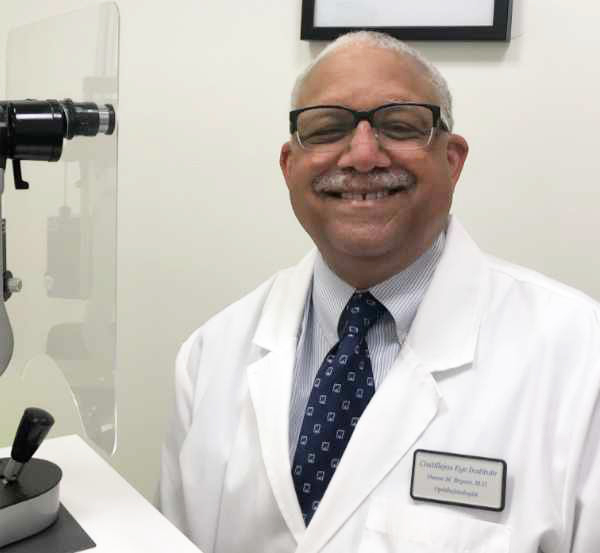Duane M. Bryant, M.D.
Board Certified Comprehensive Ophthalmologist
Sample Case Descriptions
Motor Vehicle Accident
A young woman was struck while driving by a tractor trailer truck. Her car rolled and she sustained head injuries (traumatic brain injury). The issue in this case was to determine whether the victim's visual symptoms and orbital pain were ophthalmologic in origin or were a result of post-concussive syndrome.
Mal-placement of Anterior Chambers IOL
Ms. X underwent cataract surgery by phacoemulsification. A rent occurred of the posterior capsule with vitreous prolapse. An attempt was made to place an intraocular lens (IOL) in the posterior chamber without success. Therefore, the surgeon placed an anterior chamber IOL instead. The concern in this case was whether mal-placement of the anterior chamber lens breached the standard of care and whether the mal-placement caused ongoing uveitis and cystoid macular edema (CME).
Chronic Use of Topical Steroid Medication and Uncontrolled Steroid Induced Glaucoma
Ms. X was using topical steroids prescribed by her dermatologist for several years. Ms. X also was seeing a glaucoma specialist during the same period for uncontrolled glaucoma, possibly a steroid responder. The issue in this case was whether it is a breach in the standard of care for the glaucoma specialist not to have done an adequate medication history and/or communicated with the dermatologist about the possibility of Ms. X using topical steroids on a chronic basis.
Choroidal Hemorrhage Immediately following Paracentesis
M. X had undergone cataract surgery with vitreous loss and placement of an anterior IOL. He developed elevated intra-ocular pressure (IOP) post-op. On post-op day 11, the IOP was greatly elevated and a paracentesis was performed to lower the IOP. Immediately, Mr. X experienced severe pain in the eye with elevated IOP. The issue at hand was whether or not a paracentesis should have been performed on a patient who had significant risk factors (ASCVD, HBP, Glaucoma) for choroidal hemorrhage and why he was not appropriately treated or referred for the choroidal hemorrhage, from which the patient lost all useful sight.
Pickup Truck – Bicycle Accident
Mr. X was riding his bicycle along the road and was in his appropriate lane. Mr. Y was driving along the same road in the same direction when he struck Mr. X and killed him. At issue was whether Mr. Y's poor vision was the reason for him not seeing Mr. X and striking him dead as he rode his bicycle.
Assault at Skating Rink
Mr. X was at a skating rink attending a child's birthday party when he was punched in the face, knocked to the ground, and kicked in the face. At issue in this case was whether the injuries sustained in the assault were proximate cause of Mr. X's eye injuries, which included orbital bone fractures.
ENT Surgeon Perforates Medial Orbital Wall during Ethmoidectomy
While doing an ethmoidectomy, an ENT surgeon perforated through the orbital wall, damaging the medical rectus muscle and causing an orbital hematoma. There was no consultation called for in the post-op area or that day with an ophthalmologist to see whether there was increased intra-ocular pressure causing retinal blood flow to be stopped. The issue in this case was whether the immediate post-op care was within the standard of care.
Assault Outside Bar (IME Case)
A 30-year-old gentleman was brutally assaulted outside a bar by the bartender of said bar. He was kicked in his left eye, resulting in the formation of a subluxed (misplaced) cataractous lens. He underwent cataract surgery with anterior vitrectomy and placement of an anterior chamber intraocular lens (IOL). He went on to develop uveitis and glaucoma (UGH Syndrome) and was also unilaterally presbyopic (needed a reading lens for the injured eye only). The issue in this case was to determine proximate cause and whether subsequent sequelae (uveitis, glaucoma with permanent visual field loss) were the result of the injuries suffered in the attack. In addition, the placement of the anterior chamber IOL predisposed the client to corneal decompensation. I was asked to opine on how many corneal transplants the client would require in his lifetime.
Bilateral Optic Neuropathy (IME Case)
A 60-year-old man was struck by a tractor trailer truck, resulting in multiple injuries including a broken pelvis, which had to be surgically repaired. The issue in this case was one of proximate cause of his subsequent progressive bilateral optic neuropathy. Was this due to the accident itself or the large amount of blood loss during his surgery? In addition, I was asked to produce impairment ratings using the AMA Guides to the Evaluation of Permanent Impairment, 4th Edition.
Excessive Exposure to UVA, UVB, and Blue Light during Active Military Service (Nexus Letter)
A serviceman developed Retinitis Pigmentosa (RP) while in the military that was exacerbated by excessive exposure to UVA, UVB and blue light during active military service.

"I appreciate you taking the time to do the research and explain it to me!"
"Thank you very much for working with me to update the [nexus] letter. I really appreciate your time and assistance with this matter."
Client Comments
830 Kuhn Ave #210895, Chula Vista, CA 91921
Office: 443.364.8636 Mobile: 410.365.3620
DuaneBryant@WithEyesToSee.com
© 2020 Duane M. Bryant, MD • All Rights Reserved
Site composition: Expert Communications, Inc.
Website Design & Hosting: Lemon Dog Project